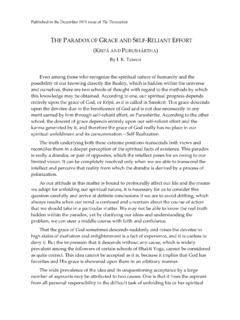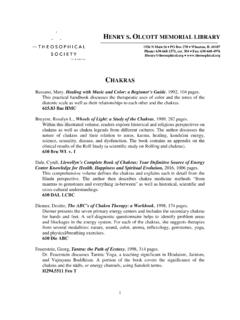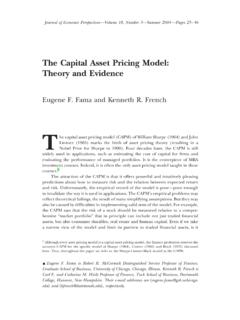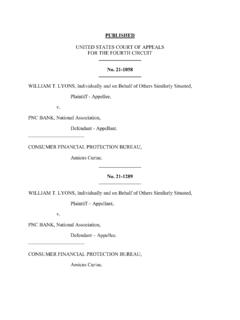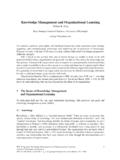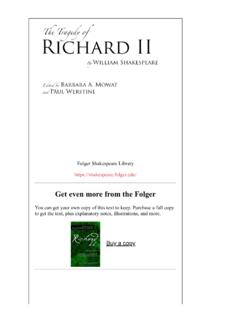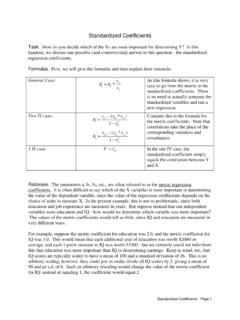Transcription of ESOTERIC PRINCIPLES - Theosophical Society in America
1 AN INTRODUCTION TO ESOTERIC PRINCIPLES FOURTH EDITION A Study Course by william Doss McDavid Department of Education Theosophical Society IN America Box 270, Wheaton, IL 60187-0270 Dedication: To the treasured memory of John Posey, Theosophist and Unknown Philosopher Copyright 1977 by the Theosophical Society in America Second Edition 1990, 1996. Third Edition (online version) 2007. Fourth Edition 2008. Abide With Me Abide with me, Thou Atmic Ray Divine, And shed Thy Light upon this soul of mine; I have no hope, no source of light but Thee; O Thou, possessing all, abide with me. When sickness rages, clouds around me throng, Be this my consolation and my song: The Lord of Light, can ne er unfaithful be, And this great King of Kings abides with me. I fear not what this world may do or say; I only fear the foe that doth betray My lower self, that shrinks away from Thee But thou art patient, Lord; abide with me.
2 I ask not ease, immunity from pain; For discipline, I know, is always gain; But sometimes, Lord, unveil and smile on me, Unworthy though I am; Abide with me. Thus through all ills, all sorrows, sickness, pain, Thy hand shall guide, my lower self restrain; And daily shall this prayer arise to Thee: Oh King of Peace, my God, abide with me. Wilton Hack The Theosophist June 1899 Contents Preface vii 1. Introduction Schools of ESOTERIC Teaching 1 2. First PRINCIPLES 7 3. Microcosm 15 4. Evolution The Law of Unfoldment 25 5. Macrocosm 33 6. The Scope of Planetary Evolution 47 7. The Path of Initiation 63 Source Materials 75 Appendix I The Seven PRINCIPLES 77 Divisions of the Human Constitution 81 Appendix II The Progress of the Lunar Monads 83 Appendix III The Twelve Creative Hierarchies 87 Occult Correspondences 88 Bibliography 89 vii PREFACE One of the most difficult tasks before the student of Theosophy is to bridge the gap between the elementary and the more advanced studies.
3 Our literature contains many examples of both extremes, but there are relatively few presentations which attempt to lead the student across the abyss which separates the two. An attempt has been made in this work to aid in bridging this abyss to some extent. It is assumed that the reader has read or studied some of the available Theosophical literature and has tried perhaps he or she may think unsuccessfully to read some of the more difficult works. It is hoped that this guide for study will provide at least the fundamentals which will prepare the student to tackle the more advanced materials, to wrestle with the perplexing questions contained therein, and to form his or her own opinions intelligently. Knotty philosophical problems and difficult points in the teaching have been dealt with as well as some of the less technical aspects. It seems necessary to point out with complete honesty and candor those points where later writers seem to be at variance with or diverge from the teaching given by H.
4 P. Blavatsky and the Masters of Wisdom in the early days of the Theosophical Society . To do so is to lay oneself open to the charge of setting up HPB as an authority. On that point, the writer can only plead guilty and beg for mercy. The writer also begs forgiveness for diverging from the teaching in those places where his own understanding is imperfect. Such is the curse which falls upon the heads of those of us who presume to write about Theosophy without ourselves being, as HPB was, the direct amanuensis of the Mahatmas. Each time this study manual has been reprinted, I have been tempted to make all sorts of changes to reflect my changing understanding over the years. Such an extensive revision would involve altering and expanding the text so greatly that it would no longer serve the purpose for which it was written. I have therefore contented myself with a minimum number of changes in hopes that the guide will continue to be useful to a certain class of students.
5 This time around I am particularly grateful to David Bruce and Nicholas Weeks for reviewing the manuscript and making suggestions for its improvement. william Doss McDavid San Antonio, TX 2008 viii The Theosophical Society in America 1 Chapter 1 Schools of ESOTERIC Teaching Theosophy has been called the Wisdom Religion. The word stems from the Greek words theos (God) and sophia (Wisdom) and refers to the Wisdom of the Gods. This Divine Wisdom, tradition relates, was brought to earth in the infancy of humanity by a superhuman race, the leaders of which have been remembered as the gods and legendary heroes of mythology. It was these great beings who taught humanity its first lessons in science, art, and philosophy and who laid the foundations for world culture. It is said that the Divine Wisdom was taught openly to the first human races. It was only during the time of the fourth, or Atlantean, race that it became hidden from the sight of the majority.
6 The reason for this secrecy was explained by Helena Petrovna Blavatsky in the following words: The first, semi-divine, pure and spiritual Races of Humanity .. had the truths of God, and lived up to them, and their ideals. They preserved them, as long as there was hardly any evil, and hence scarcely a possible abuse of that knowledge and those truths. But evolution and the gradual fall into materiality is also one of the truths and also one of the laws of God. And as mankind progressed, and became with every generation more of the earth, earthly, the individuality of each temporary Ego began to assert itself. It is personal selfishness that develops and urges man on to the abuse of his knowledge and power. And selfishness is a human building, whose windows and doors are forever wide open for every kind of iniquity to enter man s soul .. Hence the necessity of gradually taking away from man the divine knowledge and power, which became with every new human cycle more dangerous as a double-edged weapon, whose evil side was ever threatening one s neighbor, and whose power for good was lavished freely only upon self.
7 Those few elect whose inner natures had remained unaffected by their outward physical growth, thus became in time the sole guardians of the mysteries revealed, passing the knowledge to those most fit to receive it. (Collected Writings, 14: 40-41) Thus from those days were established the Mystery Schools in which the Wisdom Teachings were preserved for the worthy. In the early days of this present fifth or Aryan race, the predominant seat of civili-zation was in Central Asia. It was there that the parent school, the chief and oldest of the Mystery Schools, was maintained. As the Aryans spread throughout the ancient world, the Initiates among them established ESOTERIC schools in all the greatest centers of civilization. It was under the direction of these Initiates that many of the temples and monuments of antiquity were built. Often, the Aryans spread into regions where races The Theosophical Society in America 2 of Atlantean descent were practicing their own forms of esotericism.
8 Mingling with the older races, the Aryan Initiates established schools of the mysteries adapted to the cul-tural and social conditions in which they found themselves. Thus the Wisdom Religion, which was one in its foundations, became differentiated into innumerable traditions. The ancient Brahmanical religion of India was the form which it assumed as the Aryans swept southward across the Himalayas. In Persia, it became the religion of the Magi, which was later to become the Parsi faith under the reforming influence of Zoroasters. In Egypt, building upon foundations laid by the Atlanteans, the King-Initiates taught the Wisdom Religion in the seclusion of pyramids and imposing temples that remain to this day architectural wonders. Figure 1 suggests the diffusion of the primordial Wisdom-Tradition resulting in the proliferation of schools of ESOTERIC thought. Throughout the ancient world, therefore, the Initiates established Mystery Schools for the worthy while, around these, popular religions full of myth and superstition developed among the multitudes.
9 As civilization declined and mankind entered the Dark Age or Kali Yuga, as it is sometimes called, the ESOTERIC schools became more secret and hidden from sight until their very existence passed from the public eye. This was especially true in Western lands where the intolerance of the Roman Catholic Church made it necessary for the Initiates to hide altogether from public scrutiny. Secret societies, such as the Rosicrucian Order and the Masonic fraternities, preserved the The Theosophical Society in America 3 teachings of the Wisdom Religion throughout the Middle Ages and down to the present time. A reform movement, encompassing all traditional ESOTERIC orders the world over, was initiated around the time of the Lord Gautama Buddha and was brought to fruition during the life of the Tibetan teacher Tsong-kha-pa in the fourteenth century. A. P. Sinnett described this effort in the following words: Adeptship, when Buddha incarnated, was not the condensed, compact hierarchy that it has since become under his influence.
10 There has never been an age of the world without its adepts; but they have sometimes been scattered throughout the world; they have sometimes been isolated in separate seclusions; they have gravitated now to this country, now to that; and finally, be it remembered, their knowledge and power has not always been inspired with that elevated and sincere morality which Buddha infused into its latest and highest organization. The reform of the occult world by his instrumentality was, in fact, the result of his great sacrifice, of the self-denial which induced him to reject the blessed condition of Nirvana to which, after his earth-life as Buddha, he was fully en-titled, and undertake the burden of renewed incaгnations1 in order to carry out more thoroughly the task he had taken in hand, and confer a correspondingly increased benefit on mankind. ( ESOTERIC Buddhism, pp.)
